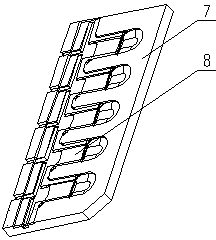High flux quantitative analysis method for visible components in human or animal excretion
A technology for quantitative analysis and excretion, applied in the field of medical inspection, can solve problems such as the inability to standardize the operation process, unstable test results, hidden dangers of biological safety, etc., and achieve the effect of being beneficial to biological protection, meeting the requirements of biological safety, and being highly representative.
- Summary
- Abstract
- Description
- Claims
- Application Information
AI Technical Summary
Problems solved by technology
Method used
Image
Examples
Embodiment 1
[0030] Taking human excretion as an example, the method of the present invention will be further described by using the measurement method of the CCD scanning sensor.
[0031] (1) Take a sampler such as figure 1 As shown, the sampler is a sampling rod 1 with blades 2 at the lower end. There are multiple blades 2 at the lower end of the sampling rod 1, which are connected together at the center and are shaped like windmill blades, and are spaced apart from each other to form a fixed-sized space area. ; A central hole 3 is provided in the middle of the sampling rod for adding diluent, and the central hole 3 is provided with multiple outlets at the junction of the blades, and the outlets are evenly distributed. The sampling stick 1 is inserted into human excretion, the sampling stick 1 is rotated, and the excretion is taken into the area between the leaves. Since the area between the blades 2 at the lower end of the sampling rod 1 is fixed and calculated during design, the sampl...
Embodiment 2
[0039] The method of the present invention will be further elaborated below in the manner of weighing and measuring.
[0040] (1) Use a limited sampler to collect human secretions as samples to be tested.
[0041] (2) Take a container with a weight of G1, and add the sample to be tested and the diluent with a weight of G2 into the container.
[0042] (3) Stir the diluent and the sample to be tested evenly to form a suspension. The stirring method is ordinary manual stirring. Put a stirring rod into the container and stir continuously for about 5 minutes, so that the diluent and the sample to be tested are fully mixed evenly to form a suspension.
[0043](4) Accurately weigh the container containing the suspension with an analytical balance of 1 / 100,000, assuming that the weight to be weighed is G3. From this, the weight of the sample to be tested in the container can be calculated as G4=G3-G2-G1, thereby calculating the concentration of the suspension.
[0044] (5) Take a t...
PUM
 Login to View More
Login to View More Abstract
Description
Claims
Application Information
 Login to View More
Login to View More - R&D
- Intellectual Property
- Life Sciences
- Materials
- Tech Scout
- Unparalleled Data Quality
- Higher Quality Content
- 60% Fewer Hallucinations
Browse by: Latest US Patents, China's latest patents, Technical Efficacy Thesaurus, Application Domain, Technology Topic, Popular Technical Reports.
© 2025 PatSnap. All rights reserved.Legal|Privacy policy|Modern Slavery Act Transparency Statement|Sitemap|About US| Contact US: help@patsnap.com



